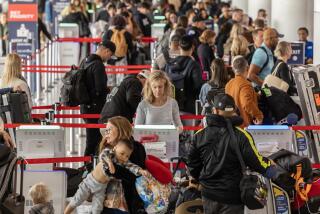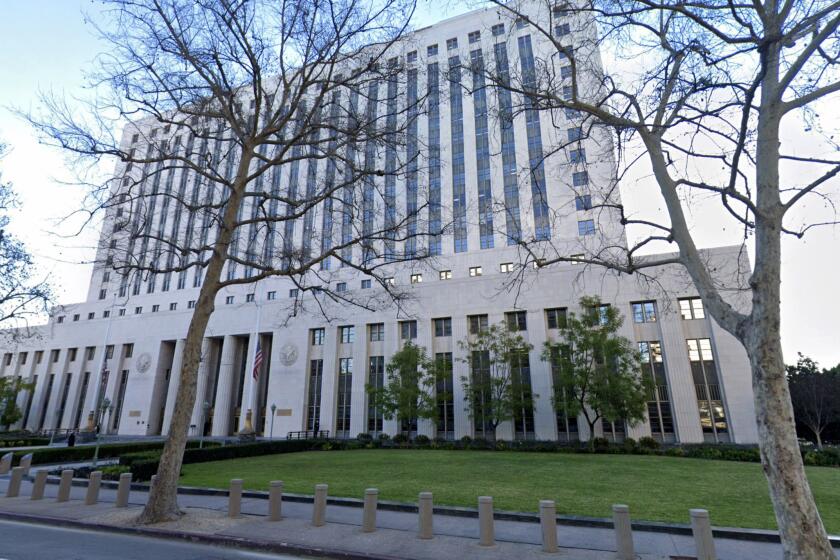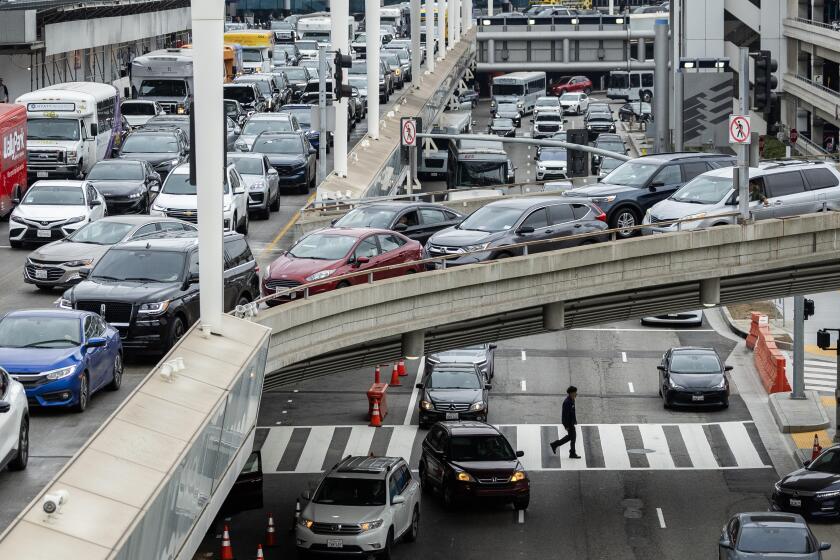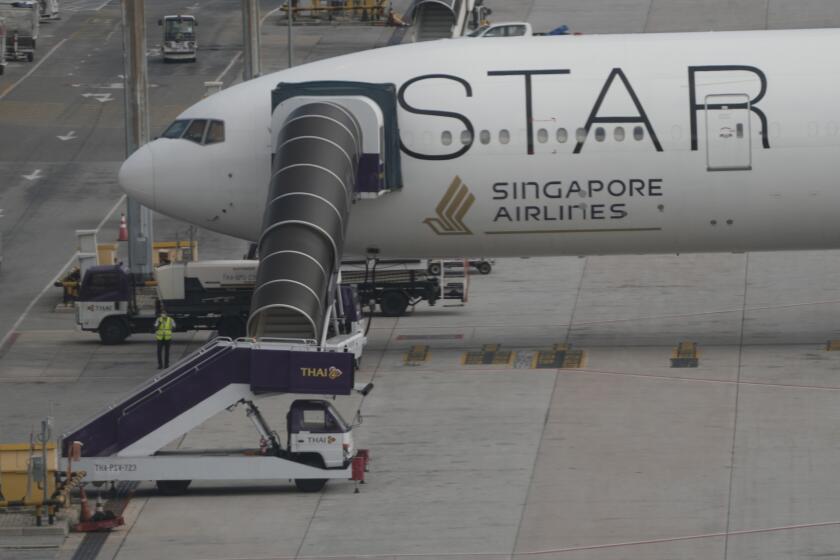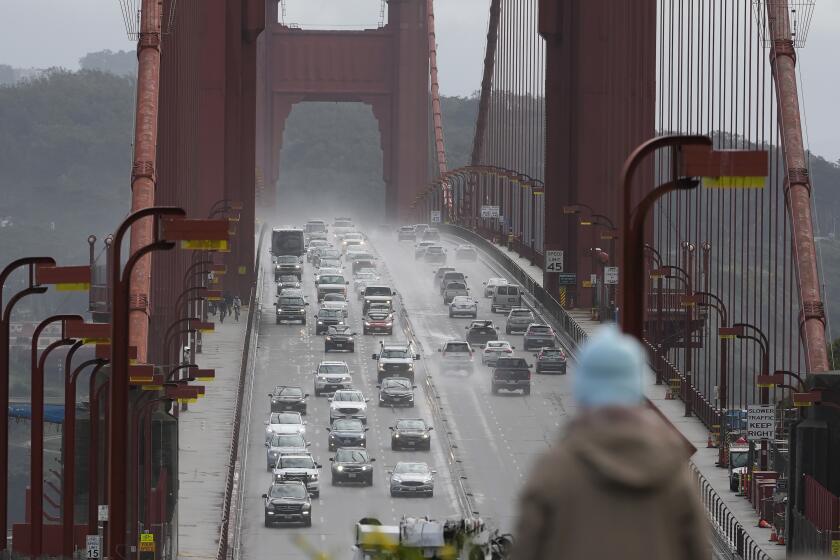Noise Variance : Van Nuys Airport May Face Trial
Unless an attempt today at an out-of-court settlement is successful, Van Nuys Airport goes on trial in February, charged with disturbing the peace.
The airport, the target of increasing attacks from anti-noise activists in recent years, is scheduled to be subjected to a state hearing on its request for a permit to continue operations, even though it does not meet the state’s airport noise-control law.
As the airport’s defenders point out, almost none of the state’s important airports do.
The hearing--precipitated by the complaints of homeowner leaders--basically will be conducted as a trial. An administrative law judge will preside. Attorneys will represent the participants. Witnesses will be called to testify under oath.
The hearing is scheduled to begin Feb. 17 at the Airtel Plaza on the east side of the airport on Sherman Way.
Preliminary Conference
First, however, participants have been invited to a preliminary conference today at the Airtel to discuss arrangements.
At that meeting, the City of Los Angeles, which owns and operates the airport, will try to reach an agreement that could avoid or shorten the trial, said Assistant City Atty. Bret Lobner, who represents the airport.
“One of the things that may come out of this prehearing conference is some sort of agreement,” Lobner said. “There’s no sense in going through litigation to prove facts that are already public and could be accepted by all parties to the hearing.”
An agreement could save time for everyone involved, he said.
But an agreement would have to include the leaders of a number of San Fernando Valley anti-noise and homeowners’ groups, who have long wanted, and eagerly pushed for, such a public forum for their complaints.
And it also would have to include anyone else who wants to complain.
The hearing has been scheduled by the state Department of Transportation’s Division of Aeronautics. Under state law, a hearing is mandatory “if one is requested by even one citizen,” said Larry Thelen, attorney for the aeronautics division.
The hearing in this case was requested by Gerald A. Silver, president of Homeowners of Encino, who is one of the most vociferous critics of the airport, and Don Schultz, president of Ban Airport Noise, the most active anti-noise group. Joining them were at least six others, most with long records of anti-airport activism.
‘Willing to Listen’
“I’m willing to listen to what the city attorney’s office has to say,” Schultz said. “But I find it hard to believe that after all these years, conditions are going to be offered at this point that would avoid a trial.”
Silver and Martin Waskow, another of those who requested the hearing, are also plaintiffs in a civil suit accusing the city of “inverse condemnation”--taking away their homes, in effect, by making them unlivable because of airport-caused “noise, smoke and vibration.” The suit was brought by 24 plaintiffs, asking a total of more than $3 million in damages.
At stake in the hearing ordered by Caltrans is the airport’s “variance,” a permit the Division of Aeronautics issues to the airport to continue operations even though it does not meet state noise-control standards.
The hearing leads to a recommendation by the administrative law judge. His opinion goes to the director of Caltrans, who makes the final decision whether to renew a variance, renew it only under certain conditions, or deny it--which would shut down the airport.
Variances are usually renewed if the owner of an airport can show good-faith efforts to meet the law, and a continuing effort to come closer to the standards.
Variances the Norm
The variances are actually the norm for most California airports with any significant commercial or private traffic load. Airport operators argue that, although modern airplanes are quieter than their predecessors, aircraft technology cannot meet the standards in the state’s noise-control law, which have grown gradually more stringent since the law was enacted 10 years ago.
“There’s hardly a commercial airport in the state that could operate without a variance,” said Lobner, who will carry the airport’s defense at the hearing. “For a large airport, it’s impossible to meet.
“Of the four airports operated by the city of Los Angeles, only Palmdale meets the standard,” he said, because of Palmdale Regional Airport’s low traffic load and the sparse housing around it. The other three--Los Angeles International, Ontario and Van Nuys--all need variances, he said.
Lobner said he will defend the airport on the grounds that it is a necessity to the city and provides financial benefits to the community.
The judge’s recommendation, he said, should take into account that the airport administration--which has no authority over pilots in the air, a preserve of the Federal Aviation Administration--has in recent years adopted and enforced a curfew, pushed for voluntary restraint by pilots and begun operation of a noise-monitoring system, he said.
Noisiest Planes Banned
The airport forbids takeoffs by the noisiest planes--those classed by the FAA as registering more than 74 decibels on takeoff--between 11 p.m. and 7 a.m. In about two dozen cases, the city has brought civil actions against pilots for violating the curfew, recovering damages of $200 to $500 in each case, Lobner said.
The penalty for a repeat offender is $2,500 and loss of the right to keep an aircraft at Van Nuys Airport, he said, “but there has never been a repeat offender.”
Also, he noted, traffic continues to decline at Van Nuys, once the third-busiest airport in the United States when measured by the number of takeoffs and landings, and the busiest non-commercial airport in the world. The city barred commercial airlines from the airport more than 30 years ago.
Although current statistics have not been compiled, the airport’s level of activity is believed to have slipped at least two or three notches. In the first nine months of 1986, it logged 361,574 landings and takeoffs, a 5.2% drop from the previous year, when traffic hit a 20-year low.
Most anti-noise protesters dispute the meaning of the figures, arguing that the heart of the noise-pollution problem is not the large number of single-engine propeller planes that use the airport, but larger business jets. The anti-noise activists propose remedies ranging from a ceiling on the number of flights, to not letting jets use the airport and changes in the way in which state regulators measure noise.
50% Reduction Requested
Silver has called in the past for a 50% reduction in operations.
Airport administrators counter that most of the protesters’ proposals are illegal under federal court rulings, and point out that the city years ago bought up and razed homes just south of the airport--the noisiest area--and turned the land into a golf course.
The noise-control problems in Van Nuys, as in most airports in the state, increased a year ago. On Jan. 1, 1985, the state standard became stricter.
The standard is based on the Community Noise Equivalent Level, a complicated, abstract method to measure noise. The CNEL is a daily average of decibel readings recorded by monitoring stations near the airport, weighted by a formula designed to reflect that noise is more annoying at night.
Aircraft noise registered between 7 p.m. and 10 p.m. is multiplied by three before being figured into the average. Noise from flights between 10 p.m. and 7 a.m. is multiplied 10 times.
The results are used to draw imaginary lines around an airport, demarcating the areas where the average CNEL reaches a common level.
The state standard, which began at 75 CNEL for residential areas, was gradually tightened until a year ago it dropped to 65 CNEL, where it will remain.
According to the Department of Airports, there are less than half a dozen homes and a dozen apartment houses in the over-65 CNEL zone on most days.
Protesters who live deep within the officially “quiet” areas insist that the figures lie.
Unless the two sides, which have agreed on little for years, come to an agreement today, the complex formulas of noise measurement, the definition of the term good faith, and the city’s powers in relation to the federal government, are all expected to become part of the trial next month.
Caltrans estimates that the trial will take at least a week.
More to Read
Start your day right
Sign up for Essential California for news, features and recommendations from the L.A. Times and beyond in your inbox six days a week.
You may occasionally receive promotional content from the Los Angeles Times.

